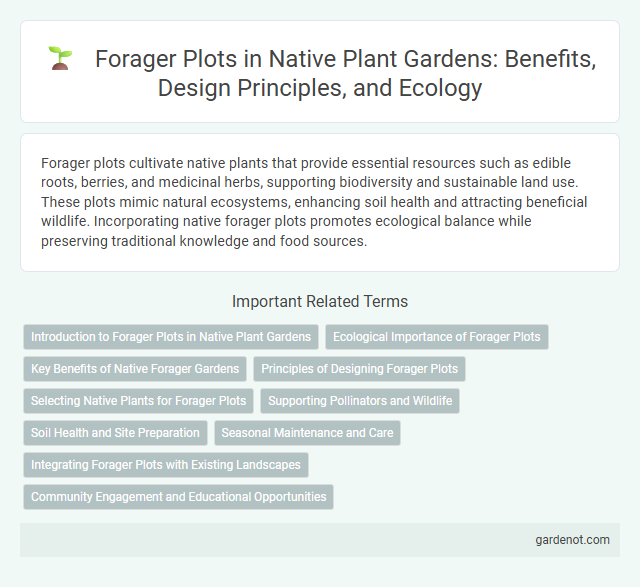Forager plots cultivate native plants that provide essential resources such as edible roots, berries, and medicinal herbs, supporting biodiversity and sustainable land use. These plots mimic natural ecosystems, enhancing soil health and attracting beneficial wildlife. Incorporating native forager plots promotes ecological balance while preserving traditional knowledge and food sources.
Introduction to Forager Plots in Native Plant Gardens
Forager plots in native plant gardens create diverse habitats that support local wildlife while providing edible and medicinal plants. These plots integrate native species such as wild strawberries, serviceberries, and ramps, promoting biodiversity and sustainable foraging practices. Incorporating forager plots enhances ecosystem resilience and connects gardeners with indigenous plant traditions.
Ecological Importance of Forager Plots
Forager plots play a vital role in restoring native biodiversity by providing essential habitats and food sources for pollinators, birds, and small mammals. These plots enhance soil health through native plant root systems that improve nutrient cycling and water retention. Establishing forager plots supports ecosystem resilience by promoting species interactions and natural pest control.
Key Benefits of Native Forager Gardens
Native forager gardens enhance biodiversity by supporting local pollinators and wildlife with regionally adapted plants. These gardens improve soil health through deep-rooted native species that prevent erosion and increase nutrient cycling. Cultivating native foragers also promotes sustainable food sources rich in vitamins and minerals, reducing dependency on imported produce.
Principles of Designing Forager Plots
Forager plots thrive by emphasizing native plant diversity, spatial arrangement, and seasonal productivity to mimic natural ecosystems. Incorporating a mix of perennial and annual species ensures continuous food supply while supporting biodiversity and soil health. Strategic placement accounts for sunlight, water availability, and wildlife interactions, optimizing plot resilience and yield.
Selecting Native Plants for Forager Plots
Selecting native plants for forager plots enhances biodiversity by providing essential habitats and food sources for local wildlife. Native species like wild berries, native herbs, and edible greens are well-adapted to regional soil and climate conditions, reducing maintenance needs and increasing sustainability. Incorporating diverse native plants supports soil health, improves pollinator activity, and promotes resilient ecosystem functions within the forager plot.
Supporting Pollinators and Wildlife
Forager plots planted with native wildflowers and shrubs create essential habitats that support pollinators such as bees, butterflies, and hummingbirds, ensuring their survival and promoting biodiversity. These plots provide abundant nectar and pollen resources throughout the growing season, enhancing pollination services for surrounding ecosystems. Incorporating native forager plants also benefits local wildlife by offering shelter and food, contributing to a balanced and resilient natural environment.
Soil Health and Site Preparation
Forager plots enhance soil health by incorporating native plants that improve nutrient cycling and support beneficial microorganisms, fostering a resilient ecosystem. Effective site preparation involves removing invasive species and minimizing soil disturbance to maintain natural soil structure and microbial communities. This approach promotes long-term soil fertility and stability, essential for successful native planting and ecosystem restoration.
Seasonal Maintenance and Care
Seasonal maintenance for a Forager plot involves regular pruning, weeding, and monitoring soil moisture to support native plant growth and nutrient cycling. Care includes mulching with organic materials to conserve soil moisture and suppress invasive species, while periodic inspection ensures early detection of pests and diseases. Implementing adaptive watering schedules aligned with seasonal rainfall patterns optimizes plant health and biodiversity in the plot.
Integrating Forager Plots with Existing Landscapes
Forager plots enrich existing landscapes by introducing native edible plants that support biodiversity and promote sustainable foraging opportunities. Integrating these plots within gardens or natural habitats enhances soil health, attracts pollinators, and provides a continuous harvest of nutritious wild foods. Strategic placement and plant diversity ensure seamless coexistence with established vegetation, maximizing ecological balance and food production.
Community Engagement and Educational Opportunities
Forager plots foster community engagement by creating interactive spaces where local residents actively participate in native planting and sustainable foraging practices. These plots serve as living classrooms, offering educational opportunities through workshops and hands-on experiences that teach plant identification, traditional uses, and ecological benefits. By connecting people with native flora, forager plots enhance environmental stewardship and promote cultural heritage preservation.
Forager plot Infographic

 gardenot.com
gardenot.com